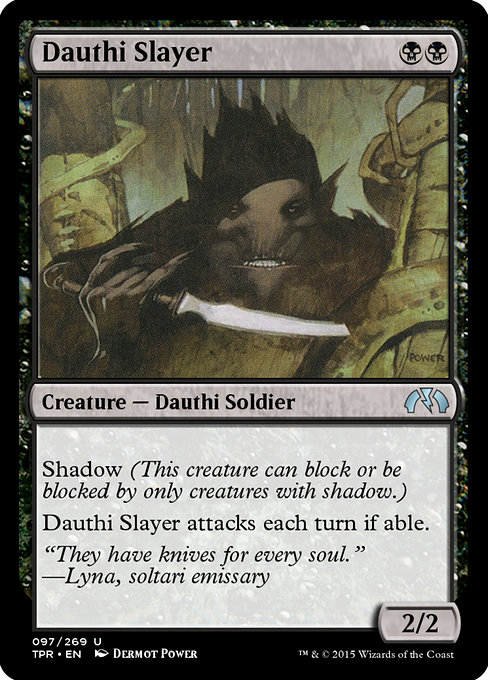
Image courtesy of Scryfall.com
Borderless and Showcase Variants through a Dauthi Lens
Magic's long history of alternate card frames has given fans a way to celebrate both art and strategy in new ways. Borderless and showcase variants have become talking points on tables and in tournament halls alike, turning familiar cards into collectible artifacts with different vibes and price trajectories. When we zoom in on a classic from Tempest Remastered, the unassuming Dauthi Slayer becomes a perfect case study: how a shadow-drenched 2/2 with a simple, brutal text box sits within a broader evolution from edge-to-edge art to ornate frame treatments. 🧙🔥💎
A quick snapshot of the card
Dauthi Slayer is a Creature — Dauthi Soldier printed as part of the Tempest Remastered set (a Masters reprint). It carries a mana cost of {B}{B}, a power/toughness of 2/2, and the iconic keyword Shadow—which means this creature can only block or be blocked by other creatures with Shadow. Its oracle text is clean and relentless: “Shadow (This creature can block or be blocked by only creatures with shadow.) This creature attacks each combat if able.” The flavor text seals the mood: “They have knives for every soul.” — Lyna, soltari emissary. In the modern card pool, this print lands in the uncommon slot and exists in both foil and nonfoil, with the original black border and a classic 2015-era frame. The art, by Dermot Power, captures a lithe, dangerous presence that feels at home in the shadowy corners of a black mana deck. 🎲⚔️
“They have knives for every soul.” — Lyna, soltari emissary
From a rules perspective, Dauthi Slayer remains a straightforward, relentlessly aggressive pick for mono-black or shadow-themed decks. The Shadow mechanic is a reminder of a different era of design, where power and positional pressure could hinge on a creature's ability to slip past ordinary blockers. In Modern and older formats, its utility comes from pressuring opponents who lean on evasive threats, while in casual Commander circles it can slot into familiars with a more aggressive tempo plan. The card’s reprint in Tempest Remastered preserves that old-school flavor even as newer frames and variant styles evolve around it. 🎨
How borderless and showcase variants reframe the experience
Borderless frames strip away the outer border to let the art fill more of the card’s real estate. They invite you to study Dermot Power’s illustration with fewer visual interruptions, and they often appeal to players who value art-first aesthetics or collectors who chase edge-to-edge glory. Showcase variants, meanwhile, introduce a decorative frame treatment or alternate presentation that highlights the art in a distinct, collectible fashion. In practice, these variants can affect perception more than pure play value—showcased cards feel like gallery pieces at the table, while borderless versions feel like cinematic moments captured in a single frame. 🧙🔥🎨
Historically, borderless and showcase variants have shown up across sets that are both old and new, sometimes as special editions or foil variants. Borderless lands first sparked broad attention in expeditions-style printings, where the land’s image leaks past the standard borders to deliver a dramatic, edge-to-art experience. Showcases appeared as an aesthetic experiment in several sets, offering players a taste of a rarer frame without altering the card’s mechanical identity. In this sense, Dauthi Slayer serves as a touchstone: a familiar, mechanically simple card that can be imagined in many different frames without changing how it plays. The collector’s imagination runs wild, even as the card stays true to its Shadows and 2/2 body. ⚔️
Practical play and modern table dynamics
Even in today’s game environment, Dauthi Slayer remains a solid, tempo-forward choice in black-centric builds. Its Shadow requirement creates an intriguing tempo dynamic on stalemates, and its attack each combat if able clause keeps up constant pressure—useful in both control-leaning and midrange shells. In EDH/Commander, its ability to contribute to early pressure in the pod can be complemented by protection and recursion; in multiplayer formats it helps to threaten several opponents at once, forcing responses you can leverage in later turns. The card’s reprint in Tempest Remastered is a reminder that classic design can still sing, even while variant frames flash in new directions. 🧙♂️💎
Collectors often weigh variant interest against raw power. In the market, borderless or showcase versions can carry a premium for certain printings, but for a card like Dauthi Slayer—the original Tempest Remastered print—the thrill lies more in history than in price spikes. The card’s foil and nonfoil options appeal to different collectors, while its under-the-radar presence in some price trackers (like low TIX values) keeps it accessible for budget-minded players who want a taste of classic black shadow without breaking the bank. The point is: variant frames add flavor and collectability, but the card’s essence remains the same on the battlefield. 🧩
Art, lore, and the collector’s urge
Dermot Power’s illustration captures a nimble, dangerous Dauthi that embodies the Kalimdor-like stealth of the race—an embodiment of the neem-knife approach that the flavor text so memorably hints at. The lore around the Dauthi in the Tempest block leans into shadow, deception, and ephemeral movement, which makes the card a natural candidate for fans who enjoy thematic subplots in their black-heavy decks. The contrast between the solemn, monochrome menace of the Dauthi and the color-rich showcases of later frames offers a playful lens for storytelling at the kitchen table or in a casual cube crafting session. 🎲🎨
If you’re chasing the perfect pairing of nostalgia and modern collectability, exploring the different frames and finishes can be a thrilling side quest. The Tempest Remastered printing—with its classic border and high-resolution art—remains a pillar in any black-mocused collection, a reminder that some designs endure with quiet authority even as the presentation shifts around them. Flipping through the card’s lore, art, and rules text feels like tracing a shadow across a wall—configuring your deck around the silhouette of a centuries-old archetype while admiring how far the frame technology has come. 🧙♂️⚔️